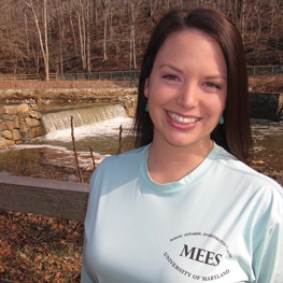Knauss legislative fellowships in Congress help build careers — and they're fun and educational. See our video and fact sheet for details.
Nicole Bransome

Fellowship Institution:
U.S. Department of the InteriorStart Year:
2013Nicole Bransome was the inaugural Knauss fellow for the U.S. Department of the Interior’s Ocean, Coasts and Great Lakes Coordination team. As a policy and communications specialist, she coordinated Interior’s work on oceans across the department’s bureaus and with federal partners.
Bransome pursued a master’s degree in the Marine Estuarine Environmental Sciences Graduate Program at Maryland. She chose the fisheries area of study because it allowed her to use science to sustain fisheries and the ecosystems, economies, and food supplies they support. For her thesis, she modeled restoration of diadromous river herring in Maine and the resultant potential recovery of their groundfish predators, like Atlantic cod.
Originally from Maryland, Bransome found a passion for marine science while volunteering with National Park biologists on studies of tidepools in San Diego. She also spent a year working for AmeriCorps in the Maryland Park Service, where she led canoe trips about marsh ecology and taught elementary-school children. At the Chesapeake Biological Laboratory, a part of the University of Maryland Center for Environmental Science, she led efforts to raise money for student research and served as president of the American Fisheries Society Student Subunit.
Call for Symposium Presenters and Authors
The Chesapeake Rising: Innovative Law and Policy Solutions for Climate Adaptation in Coastal Communities symposium will explore key legal and policy considerations that affect climate adaptation strategies. It provides a unique opportunity for upper-level law students and early-career lawyers to present and publish their legal scholarship.
Program Announcements
-
-
Maryland Sea Grant has program development funds for start-up efforts, graduate student research, or strategic support for emerging areas of research. Apply here.
News and Blogs
Video Gallery
Sea Grant Film Explores a Diminishing Smithville
Smithville is a community on Maryland’s Eastern Shore, on the edge of the Blackwater National Wildlife Refuge. A century ago, Smithville had more than 100 residents. Today, it has four, in two homes: an elderly couple, and one elderly woman and her son, who cares for her.
Featured Fellow
Featured Research Project
Developing a habitat model for mysids, an important link in Chesapeake Bay food webs
Mysids are important mesozooplankton prey for many species of fish in Chesapeake Bay and are an important link in transferring energy from lower to upper trophic levels. Mysids also serve as biological vectors for benthic-pelagic coupling due to their diel vertical migration and omnivorous prey-switching behavior, which makes mysids important regulators of food web architecture. Despite their central role in coastal food webs, surprisingly little is known about mysid ecology and dynamics in Chesapeake Bay.
The Blue Crab: Callinectes Sapidus
An essential resource for researchers, students, and managers. Get your copy today!


©2025 Maryland Sea Grant. All rights reserved.
5825 University Research Court, Suite 1350 | College Park, MD 20740
Phone: (301) 405-7500 | Fax: (301) 314-5780 | Contact Us



